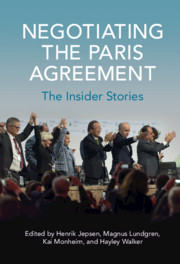Book contents
- Negotiating the Paris Agreement
- Negotiating the Paris Agreement
- Copyright page
- Contents
- Figure
- Editors
- Contributors
- Acknowledgments
- Foreword
- 1 Introduction
- 2 The Paris Negotiations: Background and Context
- 3 The French COP 21 Presidency
- 4 Mission: Adoption with Ovations: The Contribution of the UNFCCC Secretariat to the Achievement of the Paris Agreement
- 5 The Paris Agreement and China’s Imprint
- 6 The EU’s Role in the Paris Agreement
- 7 The United States: Interesting Processes and Techniques Lined the Road to Paris
- 8 COP 21 – Complaints and Negotiation: The Role of the Like-Minded Developing Countries Group (LMDC) and the Paris Agreement
- 9 The Staircase of Paris
- 10 The Battle for Small Island Developing States
- 11 The High Ambition Coalition
- 12 The Power of Civil Society
- 13 Business: Creating the Context
- 14 Why Did They Finally Reach Agreement?
- 15 Conclusion: The Landscape of Multilateral Agreement in Paris and Beyond
- Afterword
- Appendix: The Paris Agreement
- References
- Index
2 - The Paris Negotiations: Background and Context
Published online by Cambridge University Press: 24 September 2021
- Negotiating the Paris Agreement
- Negotiating the Paris Agreement
- Copyright page
- Contents
- Figure
- Editors
- Contributors
- Acknowledgments
- Foreword
- 1 Introduction
- 2 The Paris Negotiations: Background and Context
- 3 The French COP 21 Presidency
- 4 Mission: Adoption with Ovations: The Contribution of the UNFCCC Secretariat to the Achievement of the Paris Agreement
- 5 The Paris Agreement and China’s Imprint
- 6 The EU’s Role in the Paris Agreement
- 7 The United States: Interesting Processes and Techniques Lined the Road to Paris
- 8 COP 21 – Complaints and Negotiation: The Role of the Like-Minded Developing Countries Group (LMDC) and the Paris Agreement
- 9 The Staircase of Paris
- 10 The Battle for Small Island Developing States
- 11 The High Ambition Coalition
- 12 The Power of Civil Society
- 13 Business: Creating the Context
- 14 Why Did They Finally Reach Agreement?
- 15 Conclusion: The Landscape of Multilateral Agreement in Paris and Beyond
- Afterword
- Appendix: The Paris Agreement
- References
- Index
Summary
Pamela Chasek, Professor at Manhattan College and co-founder and executive editor of the Earth Negotiations Bulletin, places the Paris Agreement in its historical context by reviewing the origins and development of the climate change regime. The chapter describes the history of the UNFCCC, from its creation in 1994, through the 1997 Kyoto Protocol, over key milestones in the discussions about a post-Kyoto successor regime. The chapter traces climate negotiations over a series of COPs, including the divisive debates at the Copenhagen COP in 2009 and the efforts to rebuild the parties’ trust in the process during the following years. It details how negotiations in the 2010–14 period led countries to converge around a bottom-up arrangement for the post-2020 regime. While many contentious issues remained unresolved as negotiations entered the home stretch in 2015, Chasek describes how the French Presidency of COP 21 sought to prepare the ground for a compromise agreement, both before and during the negotiations in Paris, ultimately succeeding in bringing the parties together in support of an agreement that “represents an evolution in climate governance”.
- Type
- Chapter
- Information
- Negotiating the Paris AgreementThe Insider Stories, pp. 20 - 45Publisher: Cambridge University PressPrint publication year: 2021



